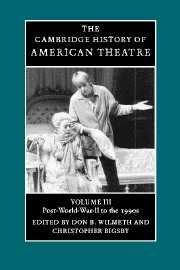Book contents
- Frontmatter
- Introduction
- Timeline: Post-World War II to 1998
- 1 American Theatre in Context: 1945–Present
- 2 A Changing Theatre: Broadway to the Regions
- 3 The Plays and Playwrights
- 4 Musical Theatre since World War II
- 5 Directors and Direction
- 6 Actors and Acting
- 7 American Theatre Design Since 1945
- Bibliography
- Index
6 - Actors and Acting
Published online by Cambridge University Press: 28 March 2008
- Frontmatter
- Introduction
- Timeline: Post-World War II to 1998
- 1 American Theatre in Context: 1945–Present
- 2 A Changing Theatre: Broadway to the Regions
- 3 The Plays and Playwrights
- 4 Musical Theatre since World War II
- 5 Directors and Direction
- 6 Actors and Acting
- 7 American Theatre Design Since 1945
- Bibliography
- Index
Summary
Background
In the beginning was the Group Theatre. Co-founded in 1931 by Harold Clurman, Lee Strasberg, and Cheryl Crawford, the Group was a young people’s theatre dedicated to producing new American plays which illuminated the troubled spirit of the times. Defecting from the Theatre Guild, the Group’s leaders designed their new theatre on native grounds. In the twenties the Guild had been America’s leading art theatre, but with the advent of the Depression the Group’s firebrands had begun to regard it as an elitist, out-dated producer of mostly foreign plays. And unlike the Theatre Guild, which claimed the no-stars policy of a repertory company but nonetheless frequently featured the Lunts as headliners, its leaders envisioned the Group as a true company united by political convictions and molded into an ensemble through the common study of a specific acting technique. In its approach to actor training the Group has had a profound and enduring impact on the formation of what has come to be known as the American style.
For Clurman and Strasberg the concept of an ensemble tightly bound by its immersion in a particular approach to actor training was sparked by the visit to New York in 1923 of Stanislavsky’s renowned Moscow Art Theatre. Having been instructed in his system by Stanislavsky himself and having worked together over long rehearsal periods on plays, like those by Chekhov, which had been written especially for them, the troupe performed in a radiant style: realism lit by a remarkable depth and unity. When two members of Stanislavsky’s company, Richard Boleslavski and Maria Ouspenskaya, remained behind to teach the principles of Stanislavsky’s system, Strasberg, Clurman, and others who were to join the Group attended their courses at the American Laboratory Theatre.
- Type
- Chapter
- Information
- The Cambridge History of American Theatre , pp. 490 - 513Publisher: Cambridge University PressPrint publication year: 2000



